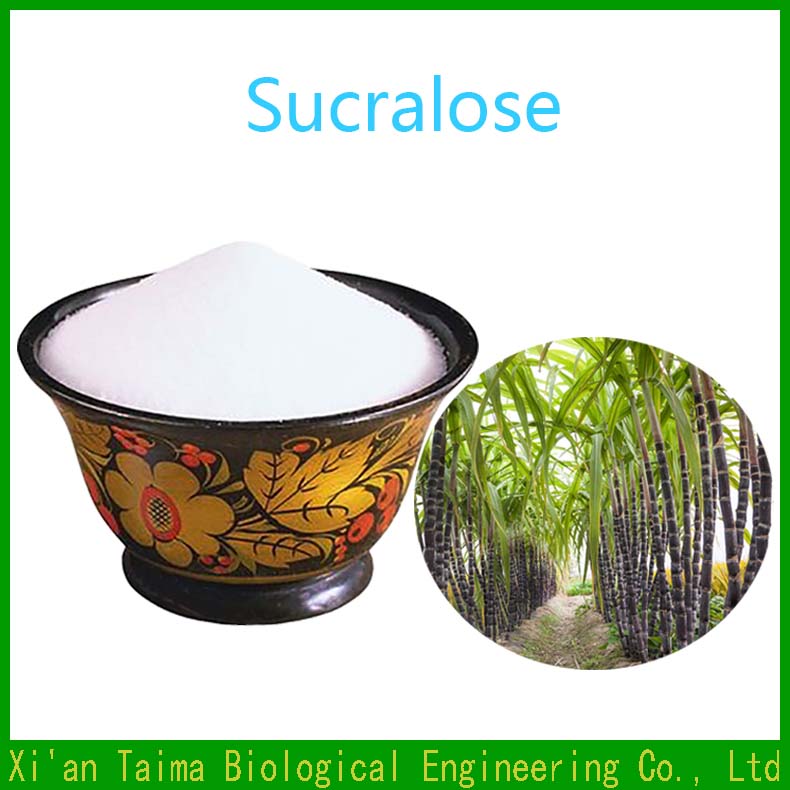
Sucralose
Product Name: Sucralose
Chemical Name:
1,6-Dichloro-1,6-dideoxy-beta-D-fructofuranosyl 4-chloro-4-deoxy-alpha-D-galactose
CAS No.: 56038-13-2
MF: C12H19Cl3O8
MW: 397.64
Appearance: White powder
Detection Method: HPLC
Purity: ≥99%
Boiling point: 104-107°C
Specific Rotation: +84.0°- +87.5°
Solubility: Freely soluble in water, in methanol and in alcohol, slightly soluble in ethylacetate.
EINECS No.: 259-952-2
Shelf Life: 2 years
Package: 1kg per bag with double plastic inside and aluminium foil bag outside, or 25kg per fibre drum with double plastic bag inside, or according to customers’ requirement.
Storage: Store in cool and dry place. Keep away from strong light and heat.
Product Description:
Background:
Sucralose was discovered in 1976 by scientists from Tate & Lyle, working with researchers Leslie Hough and Shashikant Phadnis at Queen Elizabeth College (now part of King’s College London). While researching ways to use sucrose and its synthetic derivatives for industrial use, Phadnis was told to “test” a chlorinated sugar compound. Phadnis thought Hough asked him to “taste” it, so he did. He found the compound to be exceptionally sweet.
Tate & Lyle patented the substance in 1976; as of 2008, the only remaining patents concern specific manufacturing processes.
Sucralose was first approved for use in Canada in 1991. Subsequent approvals came in Australia in 1993, in New Zealand in 1996, in the United States in 1998, and in the European Union in 2004. By 2008, it had been approved in over 80 countries, including Mexico, Brazil, China, India, and Japan. In 2006, the US Food and Drug Administration amended the regulations for foods to include sucralose as a “non-nutritive sweetener” in food. In May 2008, Fusion Nutraceuticals launched a generic product to the market, using Tate & Lyle patents.
In April 2015 PepsiCo announced that it would be moving from aspartame to sucralose for most of its diet drinks in the US, due to sales of Diet Pepsi falling by more than 5% in the US. PepsiCo says its decision is a commercial one – responding to consumer preferences.
Functions:
- High sweetness, 600, 650 times sweetness than cane sugar.
- No Calorie, without leading to put weight.
- Pure tastes like sugar and without unpleasant aftertaste.
- Absolutely safe to human body and suitable for all kinds of people.
- Without leading to tooth decay or dental plaque.
- Good solubility and excellent stability.
Applications:
- Beverage, Original juice, carbonated soft drink, fruit drink and tea drink.
- Health foods, medicine and other low-sugar products used by patients with obesity, diabetes and cardiovascular disease.
- Fermented foods, Milk, flavored milk and imitation milk products.
- Canned fruits and preserves. Candies, Chewing gum, peppermint candy, hard candy, soft candy and throat-wetting candy.
- Rapid filling beverage production lines.
- Sweet food, Frozen dessert products Gel, pudding and jelly, sesame paste, breakfast cereal, and sugar for dining table.
- Others, Salad dressing, seasoning, condiment, sweetener, extract of spice, meat products, mixture of soup and soup.
Usage:
Sucralose powder can be found in more than 4,500 food and beverage products. It is used because it is a no-calorie food sweetener, does not promote dental cavities, and is safe for consumption by diabetics. Sucralose is used as a replacement for, or in combination with, other artificial or natural Sweeteners such as Aspartame, acesulfame potassium or high-fructose corn syrup.
Delivery Time: within 3 -7 days after receiving payments
Shipping Details: DHL, TNT, FEDEX or EMS.
Payment Terms: T/T, West Union, Paypal and Escrow service.
Company Information:
Xi’an Taima Biological Co., LTD. was founded in 2008, is a technological export-oriented private enterprise with the Rights of Self-Managed Import and Export, specializing in active ingredients modernized and industrialization research, development, production, and sales of natural medical botany.
Our factory covers an area of 6,000 square meters equipped with advanced equipment and the production process is in accordance with FDA.
